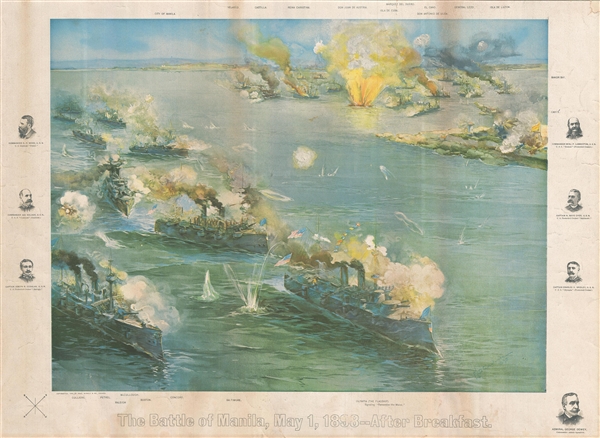This item has been sold, but you can get on the Waitlist to be notified if another example becomes available, or purchase a digital scan.
1898 Rand McNally View of the Battle of Manila
BattleofManila-randmcnally-1898
Title
1898 (dated) 19 x 26 in (48.26 x 66.04 cm)
Description
The American Asiatic Squadron under Commodore George Dewey engaged and destroyed the Spanish Pacific Squadron under Admiral Patricio Montojo. At 5:41 AM, with the now famous command, 'You may fire when ready, Mr. Gridley,' Commodore Dewey instructed Olympia's Captain to begin the bombardment of the Spanish fleet. After a furious exchange of fire, Captain Gridley messaged Dewey that only 15 rounds ammunition remained per gun. Concerned, Dewey ordered an immediate withdraw. So as not to alarm the crew, he announced that they were 'pausing for breakfast' – which they proceeded to enjoy. During this historic 'breakfast' it became apparent that the communication has gone awry and that the actual message was that Gridley has 'expended only 15 rounds of ammunition per gun.' The Battle commenced at 10:40 AM and followed with the surrender and total destruction of the Spanish squadron. The Spanish colors were struck at 12:40 PM.
This view was painted in 1898, shortly after the battle itself. A printed signature appears in the lower right corner of the image, but it is alas undecipherable. This chromolithograph view of the battle was printed by Rand McNally of Chicago.
Cartographer
Rand, McNally and Co. (fl. 1856 - present) is an American publisher of maps, atlases and globes. The company was founded in 1856 when William H. Rand, a native of Quincy, Massachusetts, opened a print shop in Chicago. Rand hired the recent Irish immigrant Andrew McNally to assist in the shop giving him a wage of 9 USD per week. The duo landed several important contracts, including the Tribune's (later renamed the Chicago Tribune) printing operation. In 1872, Rand McNally produced its first map, a railroad guide, using a new cost effective printing technique known as wax process engraving. As Chicago developed as a railway hub, the Rand firm, now incorporated as Rand McNally, began producing a wide array of railroad maps and guides. Over time, the firm expanded into atlases, globes, educational material, and general literature. By embracing the wax engraving process, Rand McNally was able to dominate the map and atlas market, pushing more traditional American lithographic publishers like Colton, Johnson, and Mitchell out of business. Eventually Rand McNally opened an annex office in New York City headed by Caleb S. Hammond, whose name is today synonymous with maps and atlases, and who later started his own map company, C. S. Hammond & Co. Both firms remain in business. More by this mapmaker...

